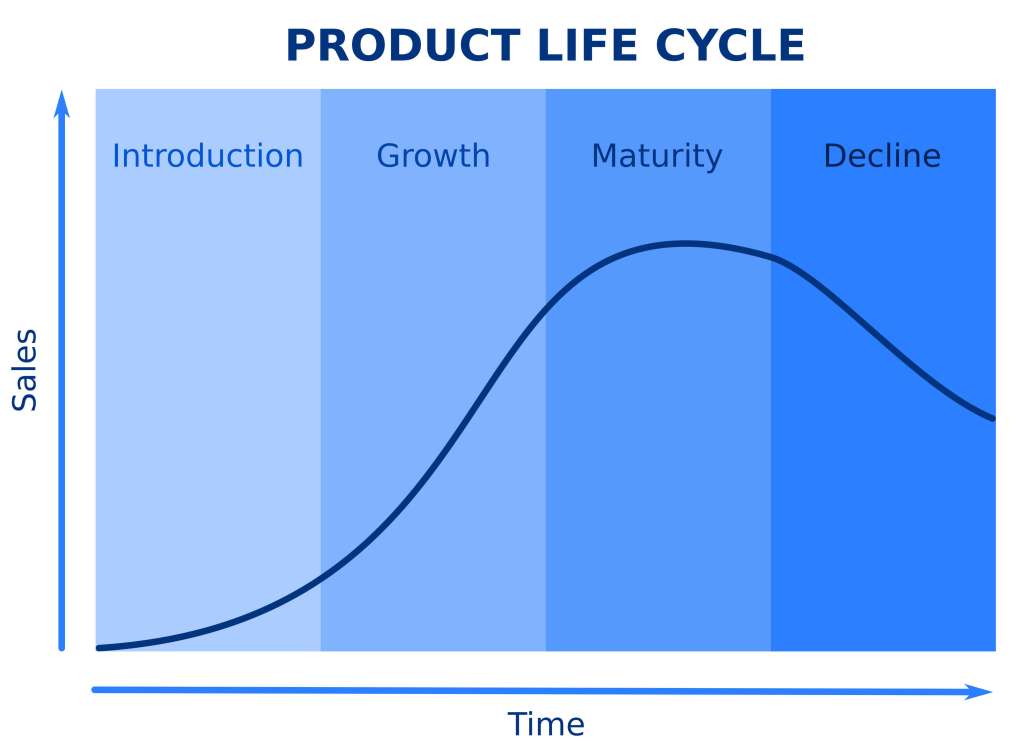Ever wanted to get a new mobile phone as soon as a new model is released? Or perhaps you fondly remember the days of renting a movie from Blockbuster long before Netflix came along?
This change in demand for a product over time is known as a ‘product life cycle’.
Here we explain a bit more about what the product life cycle is, the different stages a product goes through, and why knowing this can help you make your business a success.
What is a product life cycle?
The life cycle of a product is a useful theory to understand, analyse, and apply to your business. It looks at the period of time a product exists on the market, from launch and growth through to eventual decline.
Analysing the life cycle of your products can help with anything from working out your marketing plan and pricing to generally managing the health of your business.
Product life cycle stages
There are typically four stages of the product life cycle. However, this doesn’t take into account the ideas and development phase at the beginning, and you may well evolve and iterate your product along the way.
Stage 1: Introduction
This first stage is when your product is ready to be launched to market. Demand will be low, so you’ll be investing time and money into advertising and marketing to let customers know about your new product.
Stage 2: Growth
Now your product is established in the marketplace and you’re beginning to see demand and profits increase. Keep up with your growth strategy and you may also see more competitors appear on the scene as they try to replicate your success.
Stage 3: Maturity
This tends to be the longest stage of a product’s life cycle. You’ll notice the growth level out and you might choose to reduce your prices to stay competitive. If you think you’re heading towards decline, it’s time to review your marketing strategy or consider making changes to your product.
Stage 4: Decline
If you notice a drop in sales and revenue over time, it may be a sign that your product is in decline and could soon become obsolete.
However, that’s not to say once a product is in decline, it can’t be revived.

For example, vinyl records lost broad appeal with the rise of tapes, then CDs and online streaming. But we’ve seen a vinyl resurgence over the past 14 years, and the music format is now firmly back in fashion as consumers look for a high-quality sound and a tactile experience.
Product life cycle diagram
The four stages of a product life cycle are usually displayed as a graph with time on the x axis and sales on the y axis (like the example below).

Example product life cycle
When it comes to an example of a product life cycle, just think of the iPhone and how Apple brings out a new model each year. It’s a marketing strategy that encourages consumers to buy the latest model so they can benefit from increased functionality and excellent design features.
As a result, older iPhone models see a decrease in demand but the newer, more expensive model rises in popularity.
Product life cycle management
No one wants to see their product go into decline and become obsolete. So, here are some product life cycle extension strategies that can help keep people interested:
change your packaging – sometimes just changing the way the product looks on the shelf can increase demand. For example, by keeping sustainability in mind with your packaging materials or giving your product labels a refreshed look
release a new version – as we mentioned earlier in the Apple example, another way to boost sales is to bring an updated version of your product to market, perhaps with new features or improved technology
try another market – if interest is falling in one target market, you could explore whether your product appeals in a different location (for example if there’s lots of competition in one area), or to a whole new demographic
For more about the product development life cycle when it comes to launching new products, read our guide to developing a product.
Do you know of any other strategies you can use to extend a product life cycle? Let us know in the comments.
Small business guides
- A guide on how to price a product
- How to write a business plan: step-by-step and free template
- How to do competitor analysis
- Unique selling point examples – find your USP
- What type of business insurance do I need?
Photograph 1: WavebreakMediaMicro/stock.adobe.com
Photograph 2: AboutLife/stock.adobe.com
Photography 3: niki99/stock.adobe.com
Looking for self-employed insurance?
With Simply Business you can build a single self employed insurance policy combining the covers that are relevant to you. Whether it’s public liability insurance, professional indemnity or whatever else you need, we’ll run you a quick quote online, and let you decide if we’re a good fit.
